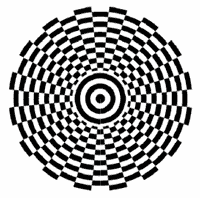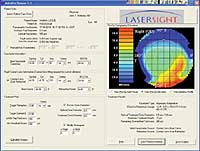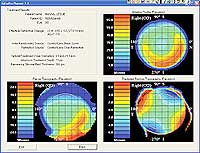Wavefront technology, from many manufacturers, shows promising results
Several customized ablation systems advancing through clinical trials show results equal to or better than standard ablation.
The promise of wavefront-guided custom corneal ablation has been on the horizon for several years. All major excimer laser manufacturers have systems in development, some of which are now in phase 3 trials. But so far the technology has not reached the clinics of most ophthalmologists.
As part of our Spotlight on Refractive Surgical Lasers, Ocular Surgery News reviewed the latest data from trials of major wavefront analysis systems in development. Researchers who have spoken at recent meetings, from last year’s American Academy of Ophthalmology to Hawaii 2002, provided updates on clinical results and their impressions of the systems’ efficacy.
LADARVision and CustomCornea
Ronald K. Krueger, MD, reviewed results with the LADARVision 4000 Ex cimer Laser System and LADARWave Custom Cornea Wavefront System from Alcon.
The LADARVision is a small scanning spot laser that uses a Gaussian spot pattern. According to Dr. Krueger, the Gaussian spot allows for minimal ablation error due to small deviations and makes a smooth ablation in properly aligned cases. The scanning spot gives the LADARVision “near-infinite ablation flexibility,” he said. No apertures are necessary, and the Z direction of tracking is “unimportant” because the Gaussian spot does not diverge.
Dr. Krueger said the eye tracker used with the LADARVision system is capable of tracking all saccadic eye movements, which can occur at five times per second. The LADARVision tracks eye movements to within 1 ms of the actual saccade, which, Dr. Krueger said, reduces physician error to a maximum of 30 µm from the intended location.
According to Dr. Krueger, a frequency of about 1,000 Hz is needed to accurately track all eye movements, and the LADARVision tracker operates at 4,000 Hz.
“The closed-loop tracker is really the only one that provides a perfectly stable image throughout the entire saccadic eye movement and can follow movements up to 150 mm per second with a precision of 30 µm,” he said.
Dr. Krueger said the LADARWave CustomCornea Wavefront System is a Shack-Hartmann-style device that measures refraction and ocular aberrations. He said CustomCornea uses a 6.5-mm diameter treatment zone and a 1.25-mm wide blend zone. The device currently measures fourth-order aberrations, with a capability of up to eighth-order aberrations.
Dr. Krueger described a clinical study of these devices that included 82 eyes with follow-up of up to 6 months. He said a majority of the custom-treated patients are achieving 20/20 or better visual acuity at 6 months. When looking at actual manifest refraction using just the wavefront information, Dr. Krueger said patients were slightly undercorrected without any nomogram adjustment. “However, when you look at best corrected visual acuity, you can see rather good numbers; 93% at 6 months are 20/16 or better, and 45% are 20/12.5 or better,” he said.
Custom-treated eyes also had less loss of contrast sensitivity and a significantly larger reduction in higher-order aberrations than eyes treated without the CustomCornea system.
Technolas 217Z and Zyoptix
Stephen G. Slade, MD, discussed the Zyoptix surgical system from Bausch & Lomb using the Technolas 217Z laser, which was approved last year.
“It’s a hardware and a software upgrade from the 217A,” Dr. Slade said, “including the ability to produce 2-mm and 1-mm spots.”
The system uses a Shack-Hartmann-based wavefront aberrometer and the Orbscan topographer to provide screening information and depth. Dr. Slade said the software separates lower-order aberrations from higher-order aberrations.
“It also gives you a nice schematic, which is useful diagnostically to describe to the patient what they might see uncorrected, what they would see with a standard correction and then what their point spread function would be if they had a customized correction taking care of their higher-order aberrations,” he said.
Dr. Slade said the laser has a standard 2-mm top-hat beam that rapidly removes tissue and a 1-mm spot-truncated Gaussian beam capable of fine carving. He said the Gaussian beam is used more in the higher-order aberrations.
“The eye tracker, in my estimation, is excellent,” Dr. Slade said. “If you look at the reaction time — not only how fast it samples and how often it samples, but the time from when it samples to when it moves the mirror — that’s within range of the top in the industry.”
Dr. Slade said the eye tracker is patient- and surgeon-friendly because pupil dilation is not necessary and the laser can still be used when the tracker is turned off.
Dr. Slade described several studies Bausch & Lomb has done using the 217Z and Zyoptix. According to Dr. Slade, in a European study including patients with attempted corrections of up to 6 D of cylinder and up to 12 D of myopia, results appear to be highly stable over time. He said a few hundred patients have been followed for 3 months and 430 for 1 month. Follow-up on these patients is continuing.
Dr. Slade said U.S. data on 40 patients from phase 1 trials appear stable out to 3 months, and he said a phase 2 study is underway with about 270 eyes completed.
According to Dr. Slade, safety seems to be improving over previous study results, and they have seen increased effectiveness in treating various higher-order aberrations, particularly vertical coma, with the Zyoptix.
“If we look at the overall induced higher-order [root mean square error], with a 6-mm pupil, we’re adding less aberrations to the eye,” he said. “The flap alone will add about 20% and the ablation will add about 50%.”
“Zyoptix or any aberrometer can’t treat what it can’t measure,” he said, “and those aberrations added by the simple surgery itself aren’t available to be measured preoperatively. So this is going to be a regression-formula solution, and we’re going to need reliable keratomes and reliable surgeries to quantify that and put it into formulas.”
LaserSight LSX and AstraMax
Jack T. Holladay, MD, MSEE, FACS, discussed results with the LaserScan LSX and AstraMax from LaserSight. These are part of the company’s CustomEyes Planner/CIPTA software for custom ablation planning. The CustomEyes/CIPTA platform has received CE certification and is in use in several clinics in Europe.
AstraMax is a stereoscopic topographer that assesses information radially, circumferentially and stereoscopically. Its three-camera system enables individual triangulation of every point of the cornea. Dr. Holladay said the new AstraMax stereoscopic topographer produces “perfect” height data out to the periphery to 1 µm.
“AstraPro is the program that allows us to define the customized ablation and put that into the LaserSight laser,” Dr. Holladay said. “We’ve also found that we can use the AstraFit, which is a contact lens method that allows us to measure the central part of the cornea accurately to 0.125 D, even with extremely irregular corneas. We can also do image simulation, so the patient can actually preview the expected vision.”
|
Dr. Holladay said patients who would benefit most from this system are those who have worn hard contact lenses for many years. “Their corneas will be irregular with bumps and valleys, mostly below,” he said.
He cited the case of a woman who was 20/50 and had a pterygium, which made a larger bump on one side than the other.
“She had a positive Q value, which is what we want to eliminate,” he said.
Dr. Holladay said after surgery the patient’s Q value was prolate all the way out to the 6-mm zone. “The height she has now is down to 2 µm of irregularity, and under a LASIK flap we always find there is that undercorrection because the flap does not fall back down completely into the valley,” he said.
“Wavefront is the wave of the future, but like topography 20 years ago there are still some problems,” Dr. Holladay said. “The precision of the excimer laser today is no more than ± 5 µm, or 0.4 D. Higher-order aberrations in most patients who have not had surgery are much less than 1 µm.”
Nidek EC 5000 and OPD Scan
Stephen Klyce, PhD, discussed the Nidek EC 5000 and OPD Scan. According to Dr. Klyce, the OPD scan measures both the wavefront of the whole eye as well as the topography of the corneal surface in short order and short succession. The OPD Scan uses slit skiascopy, a scanning slit that bounces off the retina.
“It’s a complex system, but they’re able to use 1-mm or less diameter spots to take care of the fine, higher-order, irregular aberrations in the ocular wavefront from the whole eye,” he said.
Dr. Klyce reported on a pilot study done by Maria C. Arbelaez, MD, involving 30 eyes. In her study, Dr. Arbelaez used the Nidek MK 2000 microkeratome and the EC 5000 laser with the the OPD scan and Final Fit custom software as the guiding treatment algorithm. She compared the customized ablations with previous standard LASIK procedures.
Dr. Klyce said all patients except one were within 1 D of target refraction. In terms of efficacy, compared to a collection of eyes that were uncorrected 20/20 or better with a standard procedure, a similar set of eyes in the custom laser group was 20/15 or better and was significantly enhanced.
“In terms of safety,” he said, “with a standard procedure a small fraction of patients lost a line of vision. With the custom procedure there is, in fact, an improvement in the lines gained or lost.”
Dr. Klyce said there were not enough data at 6 months for a judgement on stability. “But I think that the custom procedure will prove to have the same stability as the standard procedures,” he said.
Dr. Klyce said there was no statistically significant difference between custom and standard LASIK eyes with the study and no difference in patients’ perceived quality of vision between the two procedures. However, he said, there was an improvement in the magnitude of some Zernike figures.
Visx Star S3 and WavePrint
Julian D. Stevens, FRCOphth, discussed therapeutic results on post-LASIK reduced-acuity patients using the Star S3 excimer laser and the WavePrint system from Visx, which uses infrared imaging with a Shack-Hartmann sensor system.
Mr. Stevens said the Star S3 employs a scanning system in which the spot size varies in diameter from 0.65 mm to 6.5 mm. A larger diameter is used for greater tissue ablation per unit time and a smaller ablation zone for a higher rate of curvature change over a small area.
Mr. Stevens talked about the results of a small study of therapeutic treatments in five patients at Moorfields Eye Hospital in England. Among the younger patients, two improved their uncorrected visual acuities from 20/30 to 20/12 and the third improved from 20/20 to 20/12. One of the older patients improved from 20/30 to 20/20, while the second older patient remained unchanged at 20/30.
He said there was an improvement in bright-light contrast sensitivity as well as an improvement in overall contrast acuity. However, because the study was so small, the differences did not reach statistical significance.
He said one of the problems with treating eyes with higher-order aberrations is that the epithelium is thickened in some areas and thinned in others. “So any representation we have is probably not representative of the final end outcome,” he said. “So we’re learning with these therapeutic treatments.”
Mr. Stevens said the fact that the Visx wavefront system uses adaptive optics suggests the system is working at full deconvolution. He said the even and odd Zernike aberrations were corrected to a similar extent in each patient. The mean sphere and spherical equivalent were what was intended, and the astigmatism was reduced.
The Visx adaptive optics system uses active mirrors moved anteroposteriorly to change the optical path length. “Essentially, by putting a series of mirrors over each Shack-Hartmann spot, it’s possible to correct the wavefront. So we have a way of measuring the wavefront in real time, correcting it in real time.
“Over time, we can measure the average sphere, we can measure the cylinder and other aberrations, and we can show the patient what it would be like to retain some of the aberrations and so forth,” he said.
According to Terrence P. O’Brien, MD, phase 3 multicenter trials of Visx WaveScan-guided ablation are showing promising results. He cited data on 103 patients with mean preop spherical error of –3.4 D (range –0.8 D to –6.5 D) and preop cylinder of 0 D to +2.8 D. At 1 month, Dr. O’Brien said, 74% of eyes had 20/16 or better uncorrected visual acuity and 95% had 20/20 or better. Also at 1 month, 79% of eyes had an uncorrected visual acuity the same as or better than their preop best corrected acuity, and 48% had a 1-month UCVA better than their preop BCVA. He said 100% of eyes were within 1 D of their intended refraction.
WaveLight and Tscherning aberrometer
Stephen F. Brint, MD, discussed the WaveLight Laser Technologie’s Allegretto Wave Analyzer system, which uses a Tscherning aberrometer for wavefront analysis. The Tscherning system projects a grid of 168 spots through the optical system, which is imaged on the retina in a 1-mm grid. The 168 spots are photographed and analyzed in a manner similar to the Shack-Hartmann system.
The Allegretto Wave Analyzer is used in conjunction with the WaveLight Allegretto Wave excimer laser, which uses a Gaussian beam of less than 1-mm diameter. Dr. Brint said it creates a smooth, nonsequential ablation overlapping with the optic zone and blending out to a treatment zone.
Dr. Brint said using visible light projected onto a grid is one advantage of using the Tscherning system as opposed to a Shack-Hartmann system, which uses invisible infrared light projected into the eye.
The system is capable of measuring from -12 D up to +6 D with an internal moving lens system to compensate for spherical error. It measures more than 8 mm of the cornea with a dilated pupil and was shown to be repeatable. Dr. Brint said the centration system used on the WaveLight aberrometer can measure from a minimum of 4 points up to whatever the surgeon desires. “Select the best one, and then the composite is used to generate the ablation profile,” he said.
Image processing for the WaveLight unit looks similar to other units that use Shack-Hartmann technology. “We can pick out the display of the lower-order aberrations and each of the higher-order aberrations up to the sixth order,” Dr. Brint said. The higher-order aberrations are used in the calculation of the treatment pattern.
Dr. Brint said the system is also accurate when used in hyperopia, measuring +2 D with less than 2% error, which, according to Dr. Brint, is negligible. “The C5 Zernike coefficient is also very reproducible,” he said.
For Your Information:
- Ronald K. Krueger, MD, can be reached at the Cleveland Clinic Foundation, 9500 Euclid Ave., Desk i32, Cleveland, OH 44195; (216) 444-8158; fax: (216) 445-8475; e-mail: krueger@ccf.org. Dr. Krueger is paid for his research on the LADARWave device.
- Stephen G. Slade, MD, can be reached at 3900 Essex, Suite 101, Houston, TX 77027; (713) 626-5544; fax: (713) 626-7744; e-mail: sgs@visiontexas.com. Dr. Slade is a paid consultant for Bausch & Lomb.
- Jack T. Holladay, MD, MSEE, FACS, can be reached at Holladay LASIK Institute, 5420 Dashwood, Suite 207, Houston, TX 77079; (713) 668-7337; fax: (713) 668-7336; e-mail: docholladay@docholladay.com. Dr. Holladay is a medical director for LaserSight Inc. and a paid consultant for LaserSight Inc.
- Stephen Klyce, PhD, can be reached at LSU Eye Center, Suite B, 2020 Gravier St., New Orleans, LA 70112; (504) 412-1329; fax: (504) 412-1315. Dr. Klyce has no direct financial interest in the products mentioned in this article. He is a paid consultant for Nidek.
- Julian D. Stevens, FRCOphth, can be reached at Moorfields Eye Hospital, City Road, London EC1V 2PD, England; (44) 207-251-4835; fax: (44) 207-431-8622; e-mail: julianstevens@compuserve.com. Mr. Stevens is a paid consultant for Visx.
- Stephen F. Brint, MD, can be reached at Brint Vision Correction Center, 3901 Veterans Memorial Blvd., Metairie, LA 70002; (504) 888-2020; fax: (504) 888-2929; e-mail: brintmd@aol.com. Dr. Brint has no direct financial interest in any of the products mentioned in this article, nor is he a paid consultant for any companies mentioned.
- Alcon Laboratories, manufacturer of the LADAR Vision and LADARWave, can be reached at 6201 South Freeway, Fort Worth, TX 76134; (817) 293-0450; fax: (817) 568-6142.
- Bausch & Lomb, makers of the ZyWave aberrometer, Technolas 217Z excimer laser and the Orbscan, can be reached at 180 Via Verde Drive, San Dimas, CA 91773; (800) 338-2020; fax: (800) 362-7006.
- LaserSight Technologies, makers of the LSX and AstraMax, can be reached at 3300 University Blvd., Suite 140, Winter Park, FL 32792; (407)678-9900; fax: (407) 678-9981.
- Nidek, makers of the EC 5000 and OPD Scan, can be reached at 47651 Westinghouse Drive, Fremont, CA 94539; (800) 223-9044; fax: (510) 226-5750. Visx Inc., manufacturer of the Star S3 ActiveTrak laser and the WavePrint, can be reached at 3400 Central Expressway, Santa Clara, CA 95051-7122; (408) 733-2020; fax: (408) 773-7278.
- WaveLight Laser Technologie GmbH, makers of the Allegretto Wave Analyzer, can be reached at can be reached at Am Wolfsmantel 5, 91058 Erlangen, Germany; (49) 91-31-61-86-0; fax: (49) 91-31-6186-111; Web site: www.wavelight-laser.net.



